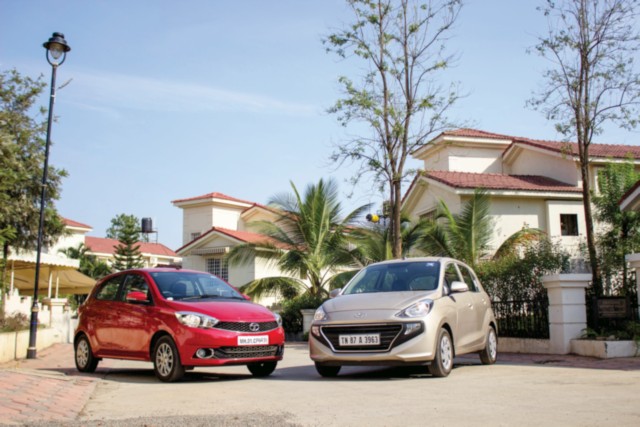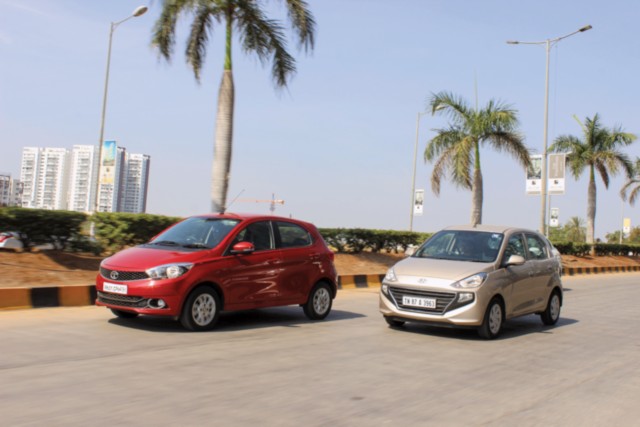
The two most contemporary hatchbacks on sale today, the new Hyundai Santro and the Tata Tiago, go head-to-head and both of them pack convenient automated transmissions.
Story: Jim Gorde
Photography: Saurabh Botre
My first car was a pre-owned 1998 Hyundai Santro that I purchased from a friend in 2010 for a five-figure sum. It had everything I considered important – space, four cylinders, adjustable headrests front and rear, windscreen wipers and the provision to add a music system. No, it didn’t have power windows, or even power steering or a working air-conditioning system, let alone airbags or a touchscreen – things considered important now. However, it served my purpose and gave me peace of mind. Now, however, peace of mind is not always a priority and many buyers need a lot more to make them happy – LED lighting, a sun-roof, and hip-hop levels of chrome. Oh, well, while whatever it is that floats their figurative boat, on a budget, it’s a different story. What constitutes a good car is – certainly not those LED lights, sun-roofs and ungodly amounts of chrome – a different matter altogether.
A good car on a budget today would have to be something sturdy, with a comfortable and reasonably well-equipped interior and, when it comes to dynamics, compact proportions, a light steering, good ground clearance, good suspension, and stable performance at city speeds and under braking. All of the latter are needed to handle the on-road and no-road situations which present themselves on and off even on a five-kilometre-long commute. Plus, with random, perennially ongoing road-work for cables and what-not, piles of dirt and uprooted concrete blocks are no strangers to an everyday commute either, depending on where one lives. With that established, comfort, practicality and, finally, efficiency should be on top of your list when it comes to buying a budget car for everyday use. There’s no point in being miserable inside your car every day and saving a few rupees by getting a few more kilometres to a litre. The subjects of our twin test today are the all-new Hyundai Santro and the Tata Tiago – two cars that have proven to offer more for less, while being exceptional over many others in more ways than one. Besides, the Santro here is the Sportz variant, priced at Rs 5.47 lakh (ex-showroom). The ‘Smart Auto’ transmission isn’t available in the top-spec Asta variant and, thus, it loses out on some important features which the manual version doesn’t have to do without. The Tiago XZA too recently became a trim one level down from the recently introduced XZ+ trim level, and costs a bit more at Rs 5.71 lakh (ex-showroom), but has a lot more kit than its Korean rival. Honestly, choosing between these two involves a proper set of tests and a lot of nit-picking in terms of everyday usability. So here goes.

The new Santro first, since it’s the return of the new kid on the block. The tall-boy design of the old car was somewhat of an inspiration, perhaps. The front face reminds me of a Peugeot 107 in some ways. The overall styling, however, is unique and there is a crease too many in my book, but whatever helps it look more contemporary and stand out of the crowd is okay. After all, you’re not paying to look at it, you’re going to be driving it. The headlamps are large, the fog lamps are placed soon below them and the wide front grille takes in enough air to satisfy the Santro’s needs. For the side profile, since looks are subjective, I think its best to refer to the pictures and make what you will. The large glass panes on the door are a plus. They let in more light and make the car appear larger than it actually is; to me anyway. The wheels are 14-inchers and get wheel-caps. Alloys are not on offer. The rear is reminiscent of the Grand i10. In effect, the Santro doesn’t really replace the defunct Santro Xing and the Eon that followed. In fact, it’s a step up, almost replacing the old i10 without any prefix. The interior is the more important part of the equation, and we’ll get to that soon.
The Tata Tiago is a properly smart-looking hatch. Tata’s Impact Design language it may be, but in my head, if Mazda were given the brief to make a hatch that is inspired by the old Chevy Camaro muscle car, I think this is what would appear. It has a sort smile which could be a hint of an evil grin – like the old ’10 Camaro SS I loved the styling of – and yet manages to look sprightly and energized. Good going on that front, Tata Motors. The side profile, too, is shapely and appears aerodynamically swoopy, with one prominent, sweeping shoulder line making it just right, almost like a sketch come to life. The car wraps up with a tight tail-section. The 14-inch alloy wheels in this XZA variant are inside flared wheel-arches look sharp and add to the driver appeal.
The Santro seems much larger at first glance. Though, they both share the same 2,400-mm wheelbase, the Tiago is over 130 mm longer than the Santro, at 3,746 mm. They’re both just as wide, but the Santro has more wheel track. It’s also 25 mm taller than the Tiago, but in terms of interior room and performance, there isn’t much between them, as we shall see.




















Leave a Reply